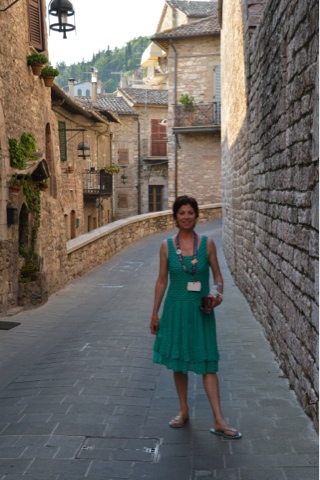Once we arrived, we waited for our guide to take us through the inside of the ancient building to tell us the stories that once were in Rome. This theater was built in 72 AD, and for the mosts part still includes its original materials. Here gladiators fought, wild animals were slaughtered, and, when the central area was flooded, sea battles took place. It is ringed by triple rows of arches, with sloping terraces within for seating. Below our guide brought pictures of how animals were kept behind trap doors before being let out to fight.
The stadium sat anywhere between 50,000-73,000 people to watch the live shows.
As you can see from our guide's picture below, in ancient days the Colosseum was white in color on the outside.
Back in the day, gladiators could volunteer to be fighters. If they won, they would become very rich. If they lost, they would give up their lives. Gladiators were only allowed to fight twice each year. Slaves were forced to fight, and their owners would be their trainers. If the slaves won battles, their prize was to continue to live and their owners would take the prize money.
Romans' tax dollars went to the battles, as this was the ultimate entertainment. After a fight, if the crowd gave a thumbs up, meaning a man standing, which would mean that they wanted to warrior to live and be saved. If they did not want the gladiator to live, they would put their thumb to the side like a man laying down, to indicate the warrior should be put to death.
Below is where the fighting took place. Animals were brought by boat from African to fight the gladiators. They wanted to reenact animals behavior of fighting in the wild, but here in the arena they would be fighting man.
If slaves survived to the end of his career, they were set free. All of the money the slaves earned went to the owners upon the slaves' death. Politicians kept the games going with money, and so did the tax dollars of the people. Virgin women were allowed into the games, but they were chosen from the richest families. They had to be virgins of 30 years in order to qualify. These young women were chosen at the young ages of between 6-10 years to someday be the virgin of the games. The life expectancy during these times was 30 years of age.
Once we completed our tour of the Colosseum, our guide walked us through the Roman Forum.
In Ancient Rome, this was the town center square. This is the former commercial, religious, and political center of the Roman Republic. Here the Senate House, shops, triumphal arches, monumental columns, and temples were rising on the famous "Via Sacra," or Sacred Street.
We didn't have a ton of time in the Roman Forum, but we did see the major sites with our guide. It is hard to imagine that this was the city thousands of years ago, and today parts of it still stands!
By now, we were tired and hungry. Our group walked to our destination for lunch where we enjoyed the Italian dish of Risotto with mushrooms and tiramisu for dessert.
After saying goodbye to Rome, we were now on our way to the quaint little town of Assisi, Italy. When we arrived in Assisi, we met a monk at a church to tell us the ways of his life and religion in Italy.
Most Italians are Catholics, and many people come to visit Assisi each year to reflect on life and their faith. The Monk's outfit represents the cross, and there are three knots in his robe which represent obedience, poverty, and chastity.
The town of Assisi is situated on the side of a mountain, and it seems as though everywhere you go, things are up hill both ways! We arrived in town for dinner and made our way to a cute little restaurant.





















No comments:
Post a Comment